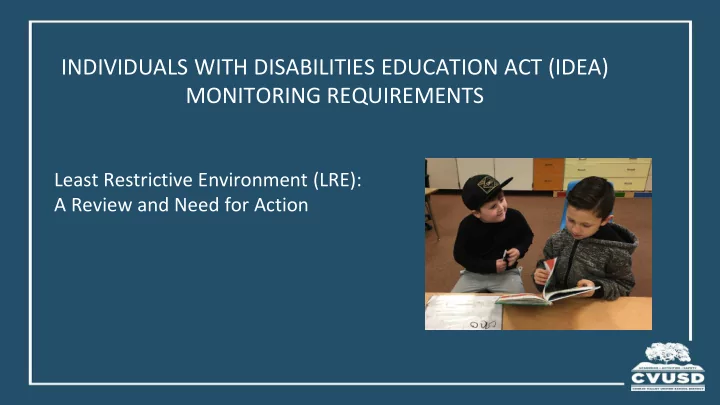

INDIVIDUALS WITH DISABILITIES EDUCATION ACT (IDEA) MONITORING REQUIREMENTS Least Restrictive Environment (LRE): A Review and Need for Action
Least Restrictive Environment Defined • “ To the maximum extent appropriate, children with disabilities… are educated with children who are not disabled, and special classes, separate schooling, or other removal of children with disabilities from the regular educational environment occurs only when the nature or severity of the disability of a child is such that education in regular classes with the use of supplementary aides and services cannot be achieved satisfactorily” 1997 IDEA, 2004 Re-authorization IDEA
Federal & State Accountability • IDEA (Federal) • All states are required to submit State Performance Plans (SPP) • Includes information on 14 “indicators” for every school district that receives IDEA funding • CDE (State) • Districts submit special education data 2 times per year • Dec 30 and June 30 • CDE evaluates the submitted data on the IDEA 14 indicators • Focus on Indicator 5: Least Restrictive Environment
IDEA Least Restrictive Environment • 4 Measurements for LRE • 80% or more time spent in general education setting • 40-79% of time spent in general education setting • Less than 40% of the day spent in general education setting • Separate school or facility • Intended to “improve the quality of education for all students, with an emphasis on students with disabilities*” *California Department of Education
State Data LRE 2015-2016 School Year* California is 8 th from the bottom *National Council on Disabilities, February 2018 Report (newer data is not yet available)
CVUSD LRE Data 2015-2016
CVUSD LRE Data 2015-2016
CVUSD LRE Data 15/16 School Year • CDE expected 49.2% of 1834 of our students with an IEP to be in general education for 80% or more of their school day • 38.6% of the 1834 students were in general education for 80% or more of their school day • CDE notified us that we were disproportionate in access to GE – we missed the target
CVUSD LRE Data 2016-2017 School Year
CVUSD LRE Data 2016-2017 School Year
CVUSD LRE Data 16/17 School Year • CDE raises the expectation each year, so they expected 50.2% of 1777 students with an IEP to be in general education for 80% or more of their school day • 39.9% of the 1777 students were in general education for 80% or more of their school day • CDE notified us that we were disproportionate in access to GE - we missed the target
CVUSD LRE Data 17/18 School Year • Data already submitted to CDE- waiting for specific findings • CDE has notified VCOE SELPA we missed the target • 3 years in a row with results indicating disproportionate percentage outside of general education
Why Monitoring LRE Matters • Student outcomes • Achievement results • A-G completion rates • High School graduation rates • College entrance rates • Prevent significant disproportionality (sig-dis) • 15% of IDEA funds must be directed to correct the sig dis indicator • CDE requires participation in a task force to conduct a root-cause analysis • District develops a Coordinated Early Intervening Services (CEIS) Plan
VCOE ELA ACHIEVEMENT ANALYSIS
VCOE MATH ACHIEVEMENT ANALYSIS
Actions Taken • Informed Staff: • Principals • Special Education Staff • Ongoing LRE Team Meetings: • Instructional Directors & Special Education Leadership • Individual school site LRE data provided to Principals • Participation at VCOE Co-Teaching trainings • Implemented co-teaching at some sites • Transition away from content-specific special education classes • DRAFT strategic plan to roll out Universal Designs for Learning (UDL)
Next Steps • Provide training to General Education Teachers • Evaluate school site master schedules • Audit and adjust secondary level course offerings • Develop and submit course requests to CSU and UC Boards • Expand co-teaching opportunities • Review inclusion opportunities and expand on successes • Ongoing professional learning for all school site staff
Thank you Questions?
Recommend
More recommend